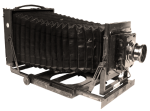Photo Formats
In the beginning the only means available to preserve the likeness of a person or scene was a painting or sketch and because of the cost involved was only available to the rich.
The first practical photographic format was the Daguerreotype developed in France in 1838. The process created a not too clear image by exposing a photosensitive silver layer on a copper plate. The result was a negative that could be seen as a positive in appropriate light, but it was fragile and needed to be sandwiched behind glass to protect it from shock and the elements. It could be expensive but many more of the general population could now afford it. The inventor was honoured by the French government and his invention was bought by the government and given to the world.
The image could not be copied, but it was very popular for about 10 years until newer methods overtook it which were more durable and could be used to make multiple prints.
Wet plate and then dry plate photography came more popular
but the processes involved were cumbersome and limited in application. George Eastman then developed the forerunner of mass produced roll film and paper printing which completely revolutionised photography allowing anyone easy access at reasonable cost.
Starting in the 1930’s 35mm still photography began to take hold and by the 1940’s 35mm slides became the norm for many home photographers until about 1970, when transparency or colour print film became more affordable.
In 1963 126 film for slides and prints
with an image of 26 x 26 mm and in 1972 110 film for prints with an image of 13 x 17 mm became popular for the budget market.
More recently film for still photography has waned in favour of digital. Though dedicated photographers may still prefer film for its wider dynamic range, reproducing dark to bright and better depth of colour.


